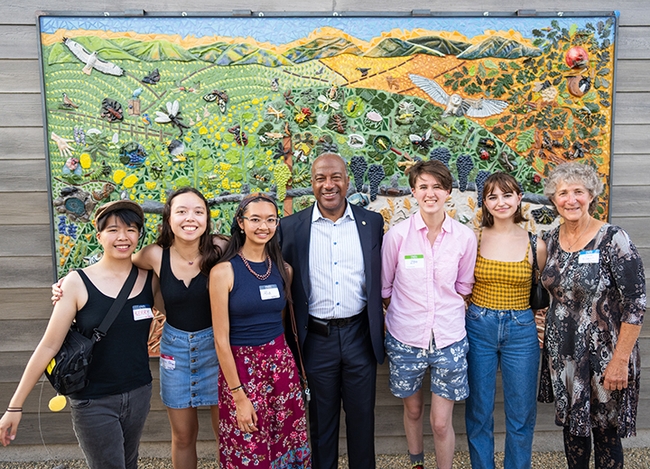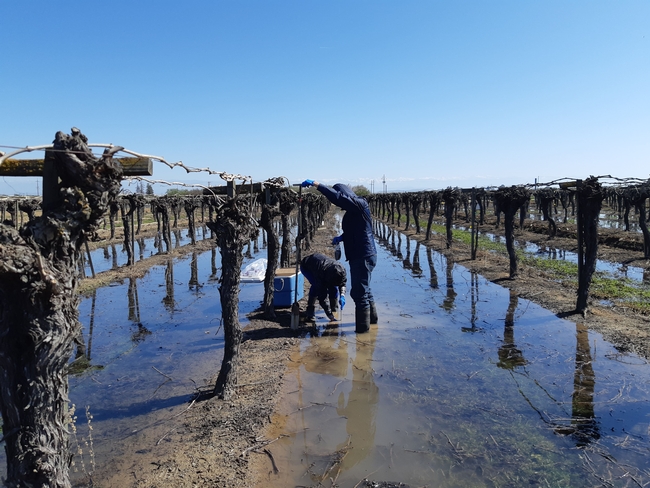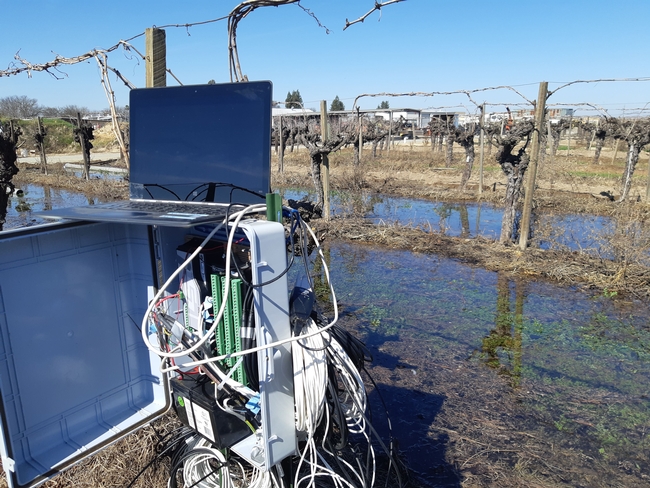Posts Tagged: vineyard
The Magic of a Mural
The magic of a mural! It was quite a celebration during the unveiling of a UC Davis ceramic-mosaic mural, The Secret Life of Vineyards, took place at a Napa Valley organic vineyard. The 10 x 6-foot mural, which graces an outer wall of the...

Posing for a celebratory photo are five mural participants with Chancellor Gary May and UC Davis distinguished professor Diane Ullman. From left are Kerry Lin, Sierra Deaver, Alia Tu, Chancellor May, Zoe Meilandt, Lily Nugent and Professor Ullman. (Photo courtesy of Jael Mackendorf, UC Davis College of Agricultural and Environmental Sciences)
UC Davis Mural, 'Secret Life of Vineyards,' to Be Unveiled at Matthiasson Winery, Napa
“The Secret Life of Vineyards,” an insect-themed ceramic-mosaic mural created by a UC Davis team and recently installed at the Matthiasson Winery on Dry Creek Road, Napa, won't be a secret much longer. The large-scale mural,...

This is the finished project, "The Secret Life of Vineyards," installed at the Matthiasson Winery, Napa. (Photo by Diane Ullman)

Students making clay artwork in the Entomology 001 class, “Art, Science and the World of Insects,” taught by UC Davis distinguished professor Diane Ullman and assistant professor Emily Meineke. (Photo by Gale Okumura)

Students engaged in glazing in the Entomology 001 class, “Art, Science and the World of Insects." (Photo by Gale Okumura)

Installation coordinator Amanda Larson, shown here with Steve Matthiasson, considers the placement of the mural on the wall. (Photo by Gale Okumura)

A forklift was an integral part of the installation effort. (Photo by Gale Okumura)

Installation coordinator Amanda Larson positions the mural. (Photo by Gale Okumura)

The mural from a distance. All that remained: grouting, which was completed in July. (Photo by Kathy Keatley Garvey)

The installation team included (from left) Valerie Jones, Susan Dileanis, Diane Ullman, Gale Okumura, Kirsten Sheehy and Teresa Slack. (Photo by Emily Meineke)
Climate-Change Resources
University of California UC ANR Green Blog (Climate Change and Other Topics) https://ucanr.edu/blogs/Green/index.cfm?tagname=climate%20change (full index)
Examples:
- Save Trees First: Tips to Keep Them Alive Under Drought https://ucanr.edu/b/~CdD
- Landscaping with Fire Exposure in Mind: https://ucanr.edu/b/~G4D
- Cities in California Inland Areas Must Make Street Tree Changes to adapt to Future Climate https://ucanr.edu/b/~oF7
Drought, Climate Change and California Water Management Ted Grantham, UC Cooperative Extension specialist (23 minutes) https://youtu.be/dlimj75Wn9Q
Climate Variability and Change: Trends and Impacts on CA Agriculture Tapan Pathak, UC Cooperative Extension specialist (24 minutes) https://youtu.be/bIHI0yqqQJc
California Institute for Water Resources (links to blogs, talks, podcasts, water experts, etc.) https://ciwr.ucanr.edu/California_Drought_Expertise/
UC ANR Wildfire Resources (publications, videos, etc.) https://ucanr.edu/News/For_the_media/Press_kits/Wildfire/ (main website)
-UC ANR Fire Resources and Information https://ucanr.edu/sites/fire/ (main website)
-Preparing Home Landscaping https://ucanr.edu/sites/fire/Prepare/Landscaping/
UC ANR Free Publications https://anrcatalog.ucanr.edu/ (main website)
- Benefits of Plants to Humans and Urban Ecosystems: https://anrcatalog.ucanr.edu/pdf/8726.pdf
-Keeping Plants Alive Under Drought and Water Restrictions (English version) https://anrcatalog.ucanr.edu/pdf/8553.pdf
(Spanish version) https://anrcatalog.ucanr.edu/pdf/8628.pdf
- Use of Graywater in Urban Landscapes https://anrcatalog.ucanr.edu/pdf/8536.pdf
- Sustainable Landscaping in California https://anrcatalog.ucanr.edu/pdf/8504.pdf
Other (Non-UC) Climate Change Resources
Urban Forests and Climate Change. Urban forests play an important role in climate change mitigation and adaptation. Active stewardship of a community's forestry assets can strengthen local resilience to climate change while creating more sustainable and desirable places to live. https://www.fs.usda.gov/ccrc/topics/urban-forests
Examining the Viability of Planting Trees to Mitigate Climate Change (plausible at the forest level) https://climate.nasa.gov/news/2927/examining-the-viability-of-planting-trees-to-help-mitigate-climate-change/
Reports and other information resources coordinated under the auspices of the United Nations and produced through the collaboration of thousands of international scientists to provide a clear and up to date view of the current state of scientific knowledge relevant to climate change. United Nations Climate Action
Scientific reports, programs, action movements and events related to climate change. National Center for Atmospheric Research (National Science Foundation)
Find useful reports, program information and other documents resulting from federally funded research and development into the behavior of the atmosphere and related physical, biological and social systems. Search and find climate data from prehistory through to an hour ago in the world's largest climate data archive. (Formerly the "Climatic Data Center") National Centers for Environmental Information (NOAA)
Think tank providing information, analysis, policy and solution development for addressing climate change and energy issues (formerly known as the: "Pew Center on Global Climate Change"). Center for Climate & Energy Solutions (C2ES)
Mapping Resilience: A Blueprint for Thriving in the Face of Climate Disaster. The Climate Adaptation Knowledge Exchange (CAKE) was launched in July 2010 and is managed by EcoAdapt, a non-profit with a singular mission: to create a robust future in the face of climate change by bringing together diverse players to reshape planning and management in response to rapid climate change. https://www.cakex.org/documents/mapping-resilience-blueprint-thriving-face-climate-disaster
Cal-Adapt provides a way to explore peer-reviewed data that portrays how climate change might affect California at the state and local level. We make this data available through downloads, visualizations, and the Cal-Adapt API for your research, outreach, and adaptation planning needs. Cal-Adapt is a collaboration between state agency funding programs, university and private sector researchers https://cal-adapt.org/
Find reports, maps, data and other resources produced through a confederation of the research arms of 13 Federal departments and agencies that carry out research and develop and maintain capabilities that support the Nation's response to global change. Global Change (U.S. Global Change Research Program)
The Pacific Institute is a global water think tank that combines science-based thought leadership with active outreach to influence local, national, and international efforts to develop sustainable water policies. https://pacinst.org/our-approach/
Making equity real in climate adaptation and community resilience policies and programs: a guidebook. https://greenlining.org/publications/2019/making-equity-real-in-climate-adaption-and-community-resilience-policies-and-programs-a-guidebook/
Quarterly CA Climate Updates and CA Drought Monitor Maps (updated each Thursday) https://www.drought.gov/documents/quarterly-climate-impacts-and-outlook-western-region-june-2022
Study offers insights on reducing nitrate contamination from groundwater recharge
Light irrigation before flooding stimulates microbes to remove nitrates from soil
With California enduring record-breaking rain and snow and Gov. Gavin Newsom recently easing restrictions on groundwater recharge, interest in “managed aquifer recharge” has never been higher. This process – by which floodwater is routed to sites such as farm fields so that it percolates into the aquifer – holds great promise as a tool to replenish depleted groundwater stores across the state.
But one concern, in the agricultural context, is how recharge might push nitrates from fertilizer into the groundwater supply. Consumption of well water contaminated with nitrates has been linked to increased risk of cancers, birth defects and other health impacts.
“Many growers want to provide farmland to help recharge groundwater, but they don't want to contribute to nitrate contamination of the groundwater, and they need to know how on-farm recharge practices might affect their crops,” said Matthew Fidelibus, a University of California Cooperative Extension specialist in the UC Davis Department of Viticulture and Enology.
A recently published study by UC scientists sheds new light on how nitrates move through an agricultural recharge site and how growers might reduce potential leaching. Researchers analyzed data from two grapevine vineyards at Kearney Agricultural Research and Extension Center in Fresno County – one flooded for two weeks, and other for four.
Understanding initial nitrate levels crucial
A key factor in mitigating contamination is understanding how much nitrate is in the soil at the outset, said study author Helen Dahlke, a UC Davis hydrologist and leader of UC Agriculture and Natural Resources' strategic initiative on water. In areas with little precipitation and cropping systems that require greater amounts of synthetic fertilizer, the accumulation of residual nitrate – resulting from nitrogen in the fertilizer not taken up by the plants – can be quite high.
“The percentage of nitrates in some soils can really increase over the years, particularly if you have many dry years in a row where you don't have access to irrigation water or natural precipitation flushing some of those nitrates out of the soil,” Dahlke said.
While intense rains in recent weeks have helped dilute nitrate concentrations naturally, farmers looking to participate in recharge during the dry years ahead should consider flooding their fields with greater volumes of water.
“If you're doing this for the first time – on-farm recharge in the winter – check your residual soil nitrate levels because if they're very high, you should apply a lot of water in order to make sure that the residual nitrate is diluted down,” said Dahlke, who also added that growers should check their soil properties for suitability of recharge projects.
She recommended using, as a “good first approximation,” the online Soil Agricultural Groundwater Banking Index map, a project led by Toby O'Geen, a UC Cooperative Extension soil resource specialist.
Researchers looking at other ways to reduce nitrates
Even before flooding the fields for recharge, there are several practices that can lower initial nitrate levels and risk of leaching. Cover crops such as alfalfa and triticale, for example, can help take up residual nitrates that accumulate from fertilizing a main crop over time.
Dahlke and Fidelibus – a co-author of the San Joaquin Valley vineyard study – both pointed to pre-flooding irrigation that encourages denitrification, a process in which soil microbes transform nitrates into gaseous forms of nitrogen.
“Those denitrifying microbes need to be stimulated to do the work,” said Dahlke. “What we have found is that if you do a little bit of irrigation before you start the flooding, increasing the soil moisture can get those microbes started and they can take out more nitrate from the soil.”
The timing and quantity of fertilizer applications are also major factors in reducing leaching. Although more growers are following high-frequency, low-concentration practices to maximize uptake by crops, Dahlke said there needs to be more emphasis on incorporating nitrogen transformation processes – such as denitrification – in the nutrient management guidelines that farmers follow.
“Implementing thoughtful nutrient management plans will play a particularly important role in participating farms,” Fidelibus added.
A more holistic view of groundwater recharge
In short, choices made during the growing season can affect those in the winter recharge season – and vice versa. For example, applying compost or other organic amendments to soil can give microbes the “fuel” they need for sustained denitrification.
“What we have found is that our denitrifying bacteria often run out of steam because they don't have enough carbon to do the work,” Dahlke said. “Like us, microbes need energy to do the work, and for microbes this energy comes from soil carbon.”
Then, adding moisture via recharge to that field with high organic content can stimulate mineralization and nitrification, processes in which microbes transform the organic nitrogen into ammonium – and subsequently nitrates – that the plants can then take up. Those naturally occurring nitrates would thus reduce the need for the grower to apply synthetic fertilizer.
“The winter on-farm recharge experiments have shown that altering the moisture regime in the winter has consequences for the nitrogen budget in the summer growing season,” Dahlke explained. “Theoretically, what we need to be doing is better integrating both seasons by keeping an eye on the soil-nitrogen balance across the whole year so that we can ensure, at the end of the growing season, the residual nitrate in the soil is minimized.”
The study, published in the journal Science of The Total Environment, was part of the post-doctoral work of former UC Davis researcher Elad Levintal. In addition to Fidelibus and Dahlke, other authors are Laibin Huang, Cristina Prieto García, Adolfo Coyotl, William Horwath and Jorge Rodrigues, all in the Department of Land, Air and Water Resources at UC Davis.
Drought focus of Water Resources IMPACT magazine special issue
UC ANR experts address emotional toll of drought
Preparing the American West for prolonged drought is the focus of a double issue of Water Resources IMPACT magazine. The California Water Commission staff are guest editors for this special open-access edition of the magazine, which is published by the American Water Resources Association.
Faith Kearns, academic coordinator of University of California Agriculture and Natural Resources' California Institute for Water Resources, is among the authors delving into how drought impacts people and the environment and how we can better prepare for the inevitable.
The first issue, published on Feb. 14, focuses on water scarcity issues confronting California and the ways these issues affect different sectors.
In “Trauma, Care, and Solidarity: Addressing the Emotional Toll of Chronic Drought,” Kearns highlights the effects of drought on mental health. She points to the spike in suicide hotline calls when wells ran dry in Southeast Asian communities in California's Central Valley.
By listening to Southeast Asian farmers, Ruth Dahlquist-Willard and Michael Yang of UC Cooperative Extension were able to “lighten the load” for them by providing pragmatic support, Kearns writes.
“The scale of some of these highly emotional issues – drought, wildfires, climate change – can make them seem incredibly difficult, if not impossible, to deal with,” Kearns said. “At the same time, they are affecting everyone living in the western U.S. on a daily basis. I wanted to highlight and provide models based on work that people – whether they are researchers, clinical psychologists, or Cooperative Extension advisors – are doing right now to ease the way.”
The authors who contributed to the double issue are a diverse array of Tribal experts, academics, nongovernmental organization thought-leaders, water managers and water policy influencers, each of whom brings their own perspective on the topic of drought. Their expertise and perspectives in climate science, water policy and water management will help inform drought-related decision-making and support policies that better prepare the state to thrive during periods of prolonged water scarcity.
In addition to Kearns, the first issue includes articles contributed by:
- Samantha Stevenson, University of California, Santa Barbara
- Jay Lund, University of California, Davis
- Ron Goode, North Fork Mono Tribe
- Andy Fecko, Placer County Water Agency
- Jeff Mount, Public Policy Institute of California, and Ted Grantham, University of California, Berkeley/UC Cooperative Extension
- Nat Seavy and Karyn Stockdale, National Audubon Society
- Kjia Rivers, Community Water Center
- Cannon Michael, Bowles Farming
- Michelle Reimers, Turlock Irrigation District
The January/February edition of Water Resources IMPACT magazine can be accessed, free of charge, on the American Water Resources Association website at https://www.awra.org under “Publications.”
The second issue, to be published in March, will focus on drought response, considering the options for adaptation. This two-part series complements the Commission's work on strategies to protect communities and fish and wildlife in the event of a long-term drought.





